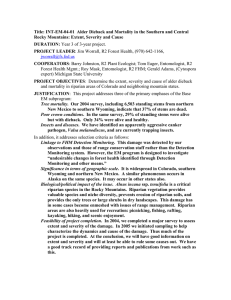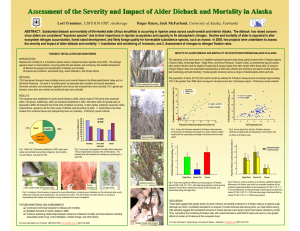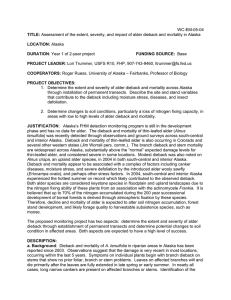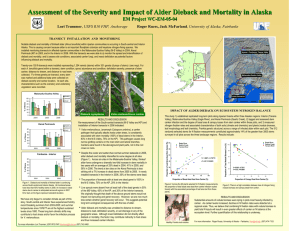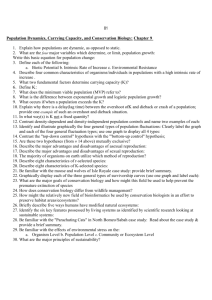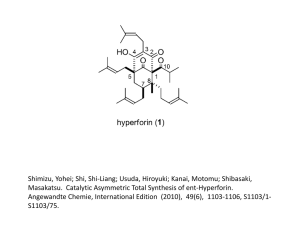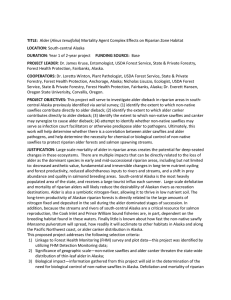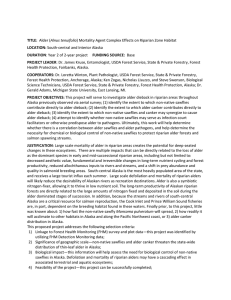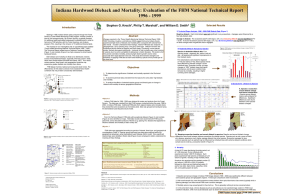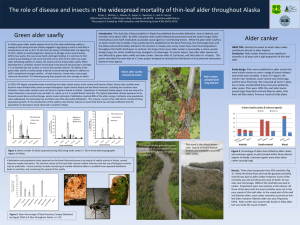TITLE: Alder Dieback and Mortality in the Southern and Central Rocky... Extent, Severity and Cause.
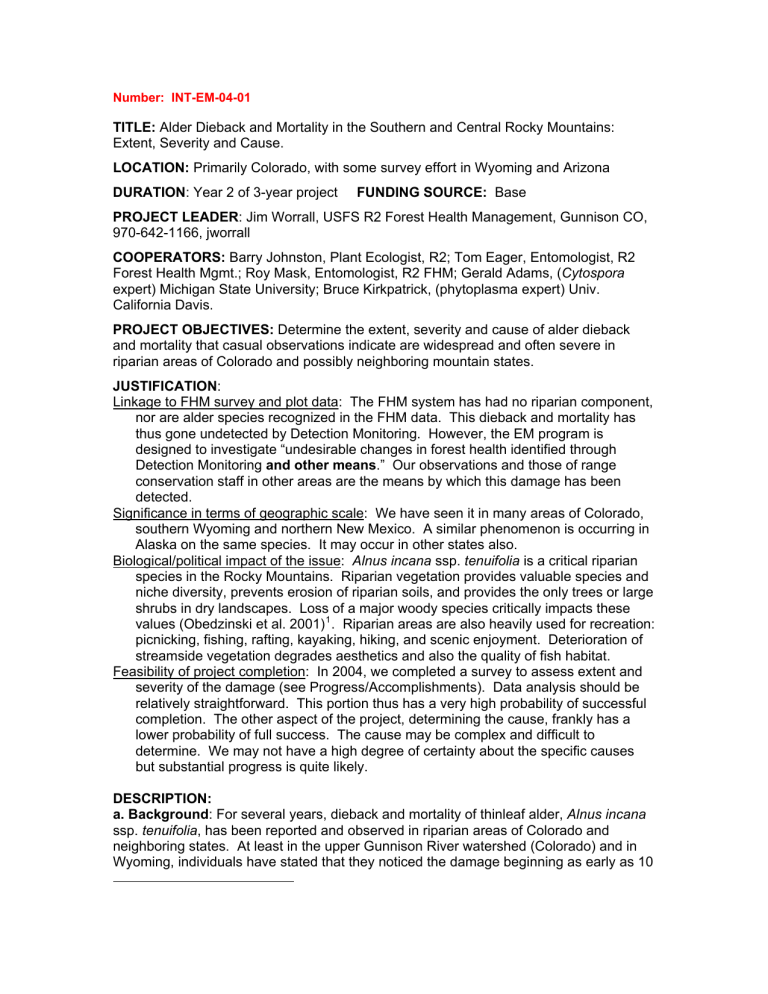
Number: INT-EM-04-01
TITLE: Alder Dieback and Mortality in the Southern and Central Rocky Mountains:
Extent, Severity and Cause.
LOCATION: Primarily Colorado, with some survey effort in Wyoming and Arizona
DURATION : Year 2 of 3-year project FUNDING SOURCE: Base
PROJECT LEADER : Jim Worrall, USFS R2 Forest Health Management, Gunnison CO,
970-642-1166, jworrall
COOPERATORS: Barry Johnston, Plant Ecologist, R2; Tom Eager, Entomologist, R2
Forest Health Mgmt.; Roy Mask, Entomologist, R2 FHM; Gerald Adams, ( Cytospora expert) Michigan State University; Bruce Kirkpatrick, (phytoplasma expert) Univ.
California Davis.
PROJECT OBJECTIVES: Determine the extent, severity and cause of alder dieback and mortality that casual observations indicate are widespread and often severe in riparian areas of Colorado and possibly neighboring mountain states.
JUSTIFICATION :
Linkage to FHM survey and plot data: The FHM system has had no riparian component, nor are alder species recognized in the FHM data. This dieback and mortality has thus gone undetected by Detection Monitoring. However, the EM program is designed to investigate “undesirable changes in forest health identified through
Detection Monitoring and other means .” Our observations and those of range conservation staff in other areas are the means by which this damage has been detected.
Significance in terms of geographic scale: We have seen it in many areas of Colorado, southern Wyoming and northern New Mexico. A similar phenomenon is occurring in
Alaska on the same species. It may occur in other states also.
Biological/political impact of the issue: Alnus incana ssp.
tenuifolia is a critical riparian species in the Rocky Mountains. Riparian vegetation provides valuable species and niche diversity, prevents erosion of riparian soils, and provides the only trees or large shrubs in dry landscapes. Loss of a major woody species critically impacts these values (Obedzinski et al. 2001)
. Riparian areas are also heavily used for recreation: picnicking, fishing, rafting, kayaking, hiking, and scenic enjoyment. Deterioration of streamside vegetation degrades aesthetics and also the quality of fish habitat.
Feasibility of project completion: In 2004, we completed a survey to assess extent and severity of the damage (see Progress/Accomplishments). Data analysis should be relatively straightforward. This portion thus has a very high probability of successful completion. The other aspect of the project, determining the cause, frankly has a lower probability of full success. The cause may be complex and difficult to determine. We may not have a high degree of certainty about the specific causes but substantial progress is quite likely.
DESCRIPTION: a. Background : For several years, dieback and mortality of thinleaf alder, Alnus incana ssp. tenuifolia , has been reported and observed in riparian areas of Colorado and neighboring states. At least in the upper Gunnison River watershed (Colorado) and in
Wyoming, individuals have stated that they noticed the damage beginning as early as 10
or 15 years ago.
Symptoms begin with branch dieback without prior foliar symptoms. Leaves and shoots die during spring (sometimes before leaves are fully expanded) or summer.
Dieback intensifies, often ending in mortality. In most, if not all, cases, long, narrow cankers with conidiomata and/or ascomata of Cytospora sp. are present on affected branches or stems. Branch mortality usually coincides with envelopment of the branch base by a canker on the main stem.
Drought does not seem to be a factor. Dieback occurs even in trees rooted partially in permanent streams, and may not occur to trees in droughty locations away from a stream. Also, the time frame of mortality extends to years before the current drought.
Hypotheses on the cause include: (i) Cytospora canker . Cytospora canker is clearly associated with dieback, but Cytospora spp. can be opportunists that attack stressed trees. Another biotic or abiotic cause therefore seems likely. If Cytospora sp. is causing a primary disease, some explanation, such as an introduced species or strain of
Cytospora , is needed. In eastern Oregon, an epidemic of Cytospora canker on alder was associated with wounding by animals and river ice (Filip et al. 1992). We have not observed consistent wounding. (ii) Phytophthora disease of alder : A lethal disease of alder, caused by a new, hybrid species of Phytophthora , was found in England in 1993 and is now known in much of Europe (Brasier et al. 1995; Brasier & Kirk 2001; Streito et al. 2002a, b). It is not known from America, but may be here. We tried to isolate
Phytophthora using a selective medium, but more attempts are needed. Stem bases, root crowns and adjacent major roots appear healthy in live plants with cankers and dieback. (iii) Alder phytoplasma : Previously known as mycoplasma-like organisms, phytoplasmas are very small, wall-less bacteria that cannot normally be isolated and are obligate parasites of phloem in roots, shoots and/or leaves, causing diseases generally known as yellows. The alder yellows phytoplasma was first described from Europe but has since been found in the U.S. (Berges & Seem ű ller 2002; Lederer & Seem ű ller 1991;
Seem ű ller & Lederer 1988). (iv) Buprestid borer : An unidentified borer and galleries have been seen in some trees with dieback. b. Methods: The survey for extent and severity was completed in 2004 (see
Progress/Accomplishments) except for data analysis. Please see “Schedule of
Activities” for more specific tasks planned for 2005 and their methods. c. Products: A technical report for managers will highlight the distribution and severity of the disease and available information on the cause and prognosis. A journal article will provide more detailed technical information on the survey, studies into the cause and association of disease severity with site and plant community features such as elevation, aspect, community type, etc. A final report is expected after the third year of the project, in late 2006 or early 2007. d. Schedule of Activities: In year 2 (2005), we will analyze survey data, assess the dynamics of the phenomenon, and focus on characterizing factors associated with the cause. e. Progress/Accomplishments: In 2004 we surveyed the extent and severity of the problem. We selected 4 th -level watersheds with ≥ 50,000 acres of federal land in or near the known distribution of alder and at elevations that would support alder. We randomly selected 14 watersheds, of which 11 were sampled in 2004. A 3-person crew established 68 transects from northern New Mexico to southern Wyoming (Fig. 1).
Although we have not yet completed substantial analyses, we know that 859 alder clumps were
Table 1. Condition of standing stems ( ≥ 3 cm dbh) in 2004 survey.
Number of stems no dieback
Live, with
Total
2,214 1,902 2,387 6,503
studied overall. Dead stems outnumbered the live, healthy stems, and two-thirds of standing stems were either dead or dying (Table 1).
Seven specimens were sent to Dr. Gerry Adams at Michigan State University for isolation, microscopic and molecular study, and identification of Cytospora . More will be sent soon from areas not covered by the earlier collections. We were not able to coordinate sampling for phytoplasmas with University of California, Davis, in 2004 but hope to do so in 2005. Insect samples were collected from foliage in all transects and put in kill jars for identification this winter. Stem sections were collected from most transects for emergence of borers. These will be maintained during the winter and any emerging adults identified.
We feel that we have enough data now, once it is analyzed, to adequately characterize the severity of the dieback and mortality. Within the area we can reasonably access, we have sufficient data to determine the extent as well.
COSTS:
2004 funding was $40,000. Funds requested for 2006 should not exceed $35,000.
For 2005, funds are requested for two seasonals for 13 weeks in 2005, a student 10 hours per week to continue laboratory work and help with data analysis during the 2005-
2006 winter, some field travel (most work will be in areas accessible from Gunnison), a visit by Dr. Gerry Adams (expert in the taxonomy, pathology and ecology of Cytospora spp.) to Colorado to help with studies involving isolation and identification, and trip by
Worrall and Adams to Anchorage for the same purpose to coordinate with Lori Trummer,
R10 FHP, who is working on a similar phenomenon on the same species of alder.
Contracting includes the work by Adams and processing of phytoplasma samples by Dr.
Bruce Kirkpatrick at U.C. Davis.
Other-Source
Funding
Source
YEAR 2, FY2005
Administration Salary 18,360
Travel
Vehicle
Procurements Contracting
Contracting
8,285
2,580
1,500
4,000
UC Davis
TOTAL
Supplies 2,000
36,725
